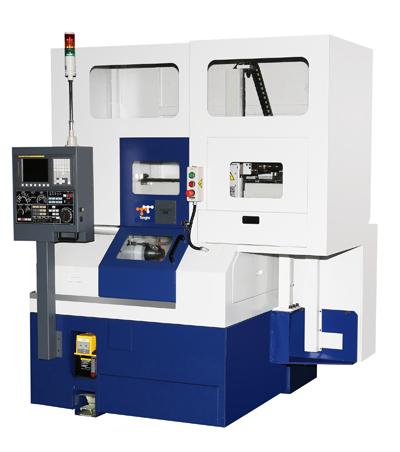
The new Tongtai Q5 CNC gang-type lathe from Absolute Machine Tools is a compact, simple machine engineered specifically for fast production of small parts. The Q5 features a 6,000 rpm (optional 8,000 rpm), 7.5 hp (5.6 kW) spindle motor and offers a rapid traverse rate of 1,181 IPM. The compact machine has a 5' x 6' 3" (1,490mm x 1870mm) footprint, and with straightforward gang tooling and no subspindle it is equipped for speed. Tool capacity, depending on the workpiece being processed, is 4-6 ID or OD tools.
Optional automation systems further increase the machine's productivity. A simple, easy-to-operate solution combines a bar feeder, part catcher, and part conveyor. Through-spindle bar capacity is 1" (25mm) -dia. For longer-term, higher-volume automated production, 8-pallet or 2-pallet gantry-loader-type part stockers are offered to handle parts up to 2" (50mm) in diameter and 1.5" (38mm) in length.
Contact Details
Related Glossary Terms
- computer numerical control ( CNC)
computer numerical control ( CNC)
Microprocessor-based controller dedicated to a machine tool that permits the creation or modification of parts. Programmed numerical control activates the machine’s servos and spindle drives and controls the various machining operations. See DNC, direct numerical control; NC, numerical control.
- inches per minute ( ipm)
inches per minute ( ipm)
Value that refers to how far the workpiece or cutter advances linearly in 1 minute, defined as: ipm = ipt 5 number of effective teeth 5 rpm. Also known as the table feed or machine feed.
- inner diameter ( ID)
inner diameter ( ID)
Dimension that defines the inside diameter of a cavity or hole. See OD, outer diameter.
- lathe
lathe
Turning machine capable of sawing, milling, grinding, gear-cutting, drilling, reaming, boring, threading, facing, chamfering, grooving, knurling, spinning, parting, necking, taper-cutting, and cam- and eccentric-cutting, as well as step- and straight-turning. Comes in a variety of forms, ranging from manual to semiautomatic to fully automatic, with major types being engine lathes, turning and contouring lathes, turret lathes and numerical-control lathes. The engine lathe consists of a headstock and spindle, tailstock, bed, carriage (complete with apron) and cross slides. Features include gear- (speed) and feed-selector levers, toolpost, compound rest, lead screw and reversing lead screw, threading dial and rapid-traverse lever. Special lathe types include through-the-spindle, camshaft and crankshaft, brake drum and rotor, spinning and gun-barrel machines. Toolroom and bench lathes are used for precision work; the former for tool-and-die work and similar tasks, the latter for small workpieces (instruments, watches), normally without a power feed. Models are typically designated according to their “swing,” or the largest-diameter workpiece that can be rotated; bed length, or the distance between centers; and horsepower generated. See turning machine.
- outer diameter ( OD)
outer diameter ( OD)
Dimension that defines the exterior diameter of a cylindrical or round part. See ID, inner diameter.
- rapid traverse
rapid traverse
Movement on a CNC mill or lathe that is from point to point at full speed but, usually, without linear interpolation.

